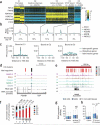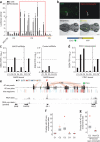Pancreatic islet enhancer clusters enriched in type 2 diabetes risk-associated variants
- PMID: 24413736
- PMCID: PMC3935450
- DOI: 10.1038/ng.2870
Pancreatic islet enhancer clusters enriched in type 2 diabetes risk-associated variants
Abstract
Type 2 diabetes affects over 300 million people, causing severe complications and premature death, yet the underlying molecular mechanisms are largely unknown. Pancreatic islet dysfunction is central in type 2 diabetes pathogenesis, and understanding islet genome regulation could therefore provide valuable mechanistic insights. We have now mapped and examined the function of human islet cis-regulatory networks. We identify genomic sequences that are targeted by islet transcription factors to drive islet-specific gene activity and show that most such sequences reside in clusters of enhancers that form physical three-dimensional chromatin domains. We find that sequence variants associated with type 2 diabetes and fasting glycemia are enriched in these clustered islet enhancers and identify trait-associated variants that disrupt DNA binding and islet enhancer activity. Our studies illustrate how islet transcription factors interact functionally with the epigenome and provide systematic evidence that the dysregulation of islet enhancers is relevant to the mechanisms underlying type 2 diabetes.
Figures






Comment in
-
A cistrome roadmap for understanding pancreatic islet biology.Nat Genet. 2014 Feb;46(2):95-6. doi: 10.1038/ng.2880. Nat Genet. 2014. PMID: 24473321 Free PMC article.
References
-
- Bonn S, et al. Tissue-specific analysis of chromatin state identifies temporal signatures of enhancer activity during embryonic development. Nat Genet. 2012;44:148–56. - PubMed
Publication types
MeSH terms
Substances
Grants and funding
LinkOut - more resources
Full Text Sources
Other Literature Sources
Medical
Research Materials

